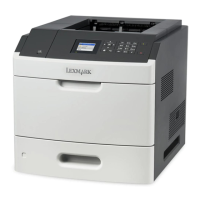HP BarDIMM compatibility intercept
17
• OCR-B
• UPC 10mil
• UPC 13mil
SAP support
When used in PCL 5 emulation mode, SAP ERP software has built-in support for many of the
functions provided by the Forms and Bar Code Card.
The following is a list of supported device types:
• LEXT622
• LEXW820
• ZLXFORM2
Lexmark-unique PCL 5 command description
Lexmark-unique PCL 5 definitions provide support for new bar code functionalities that are not
available in HP BarDIMM. Two new commands are implemented, ESC&x#W and ESC&y#W.
Bar code descriptor—ESC&x#W [descriptor data]
This escape sequence is used to describe the bar code to print, and the parameter settings required
to build the bar code. The first two bytes of this command designate the symbology. The remaining
bytes are then interpreted accordingly, based on the symbology. Each symbology has its own
defined descriptor header.
The first two bytes are required. The remaining bytes are optional. If those bytes are not sent, then
the settings are set to appropriate defaults. The # symbol represents the number of bytes of
descriptor data.
Transfer bar code data—ESC&y#W [bar code data]
This command is used to transfer a raw block of bar code data to be encoded according to the
specifications in the last valid Bar Code Descriptor command received. If no valid Descriptor is sent,
then this command is ignored and the data is flushed. The # symbol represents the number of bytes
of bar code data.
Compatibility safeguard
These commands, if sent to an HP printer, are flushed and nothing prints. Future HP PCL 5
enhancement could utilize the two escape sequences that have been chosen, forcing future Lexmark
PCL 5 emulations to honor the HP versions of these commands and to ignore them in a bar code
context.
To avoid this conflict, use the PCL 5 Lexmark enhancement switch. Setting this switch allows future
Lexmark PCL 5 emulations to decide how to interpret the new escape sequences. The switch is a
GL/2 command.

